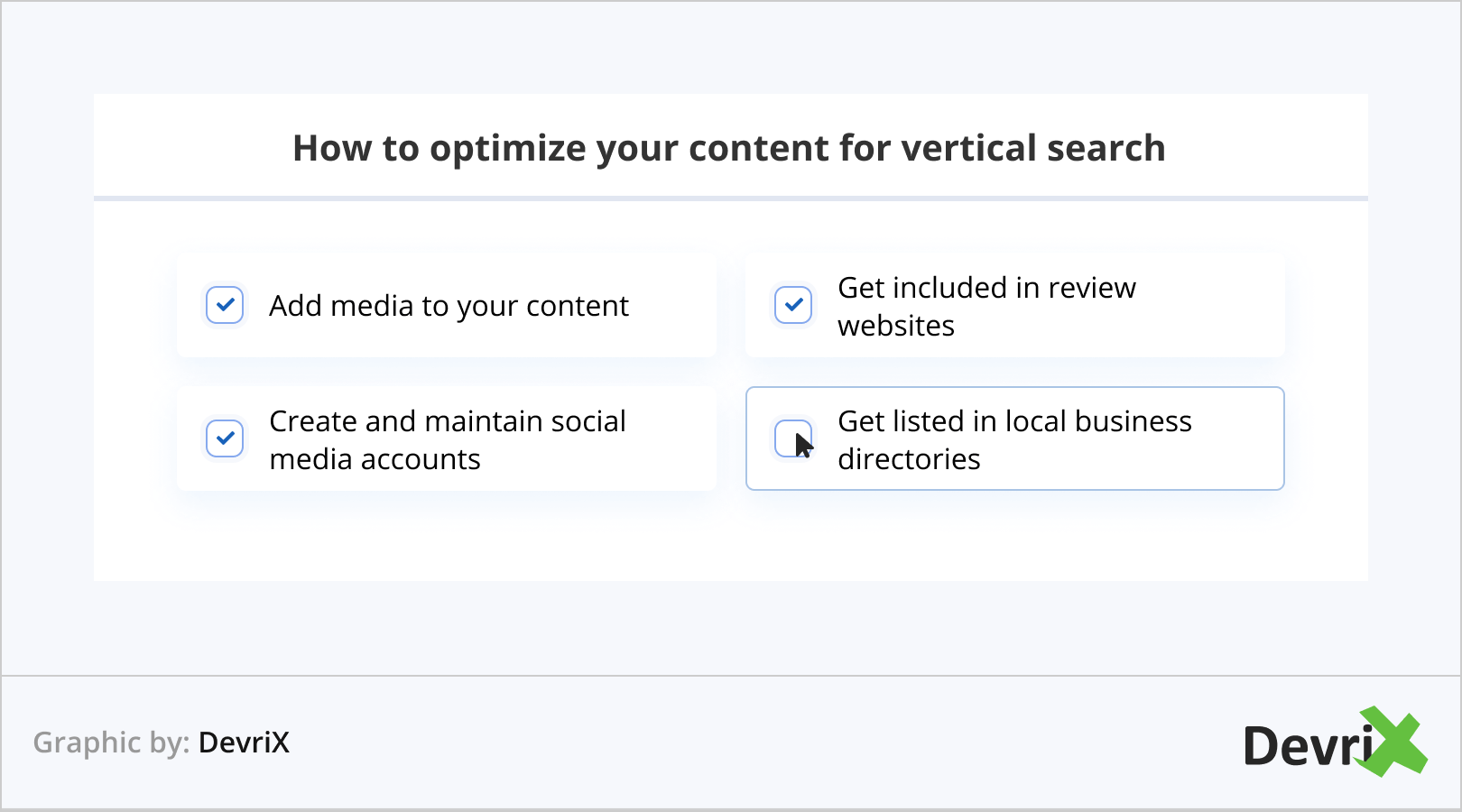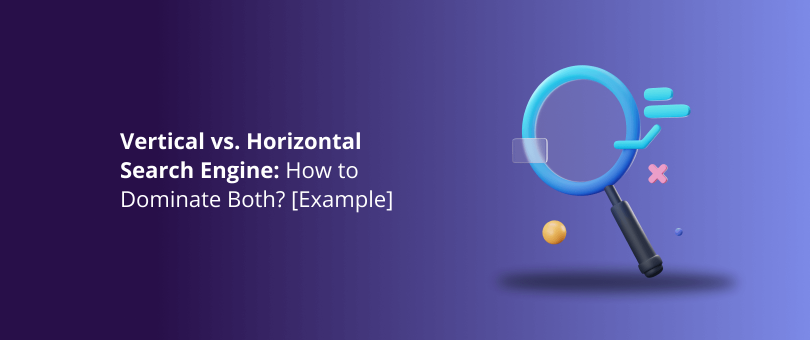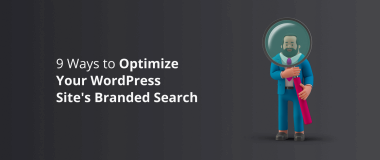Did you know that there are different types of search engines?
Even though Google is the most visited one, and dominates the search market, there are other competitors with billions of users and impressive monthly traffic.
Ever heard of vertical search? If you have, way to go!
But do you know how to optimize for it?
We thought so. However, no worries, we’ve got your back.
Today, we’re going to find out the winner in the battle of vertical vs. horizontal search engines. We’ll compare, analyze, and differentiate, and we’ll cover everything you need to know to up your SEO game.
Let’s get it on!

What Is a Vertical Search Engine?
A vertical search engine is a search engine that focuses on a specific topic, industry, or type of content. Its purpose is to attract and cater to a specialized audience and provide more relevant search results.
Most people are familiar with the way general search engines, such as Google, work: you type a keyword into the search bar, and moments later you obtain a list of suggested links, in the form of search engine result pages (SERPs), where you may find the information you’re looking for.
However, sometimes you need to find more specific information, and Google may not be able to deliver on what you’re looking for.
This is when vertical search engines come to the rescue.
You see, these types of search tools only scan a specific part of the internet, depending on your query.
This way, the results you receive are fewer, yet more focused on the topic, and thus more relevant.
Vertical Search Engine Examples
Now, let’s review some popular vertical search engine examples and analyze how you can benefit from using them:
- TinEye. This is a reversed image search engine, which is very easy to use. TinEye crawls the web for images and adds them to their index for further reference. Cette index currently includes 53 billion images!
Keep in mind that TinEye does not crawl images from social media sites, personal photographs on your device, or images on password-protected websites.
Also, your image searches are not saved, thus they remain private.
TinEye is a great way of establishing whether an image is a stock photo or copyrighted, who owns the license, where has it been already published, etc.

- Skyscanner. Interested in comparing flight prices and booking tickets? Look no further than Skyscanner. It’s a search engine and a travel agency devoted to travelers and hodophiles alike.
The tool quickly brings up an overview of all available flights for a destination and date of your choosing. On top of that, you receive additional information about the cost of hotels and car rentals in the area.
Certainly makes things easier than your ordinary Google search.

- Shopzilla. Shopzilla gathers and compares shopping results that answer your query.
Looking for a new winter coat? Simply type “winter coat” in the search bar and browse the results. You can narrow your search via the numerous options the site has on its sidebar – color, brand, features, lining, length, style, and so on.
All in all, you can find what you’re looking for much faster compared to in a horizontal search engine.
It’s not only for clothes, by the way. You can look for electronics, jewelry, home & garden products, appliances, and much more.

There are a lot more vertical search engines out there, but you get the idea. The main goal of such sites is to deliver a better user experience, provide quicker and more relevant results, and, ultimately, make your life easier.
How to Do a Vertical Search on Google?
Although Google is mostly used for general searches, it actually combines horizontal and vertical search engine functions.
How exactly?
For example, when you enter Google, select Google Maps and type an address in the search bar.
This is considered a vertical search, as you’re seeking specific information about the particular address, and you will only be delivered results in the form of addresses.
If you simply enter the address on Google, you’ll receive more wide-ranging links, such as locations, and companies that operate in the vicinity, which is probably something that you’re not interested in.
The same applies for the “video”, “news”, “images”, and “shopping” sections of Google.
Perhaps you want to know how to search vertical images in Google.
Easy.
Click on the “images” menu and from there on you can customize the search by selecting “tools” and specifying “size”, “color”, “type”, “time”, and “usage rights”.
This is why it’s important to optimize all aspects of your website, as people may find you through Google News, images, video, etc. Don’t leave things to chance, if you use rich content – optimize it and harvest the fruits of your labor.
What Is Horizontal Search?
Horizontal search is the general type of approach, where the search engine algorithm scans the whole web for results and delivers a selection of the most relevant ones. This means that the SERPs display mixed results, varying from news and articles, rich results, videos and images, and everything else that may apply.
How to Optimize For Vertical and Horizontal Search
Horizontal and vertical search engines have a lot of similarities. Ideally, you would want to cover the requirements of both when optimizing all aspects of your website.
Basically, all good SEO practices are beneficial when optimizing for both horizontal vs vertical search engines.
Here are a few general guidelines to follow:

- Write relevant image titles and alt tags. This helps crawl bots understand the purpose of your images.
- Analyze the user’s search intent and select topics based on it. There’s no point in writing and optimizing articles that (almost) nobody will read.
- Present appealing headlines and high-quality articles. Content is king, and quality will help you rule the internet.
- Use rich content. Images, videos, infographics, and GIFs are all a great way to add more value to your content, as different types of media help the article to be more interesting, and benefit SEO as well.
- Take advantage of schema markup. This will help search engines to obtain a better understanding of your content and, as a result, index them more accurately and show them to more relevant queries. Also, the algorithm may use the information too and will present rich results like reviews, products, events, etc.
How to Optimize For Vertical Search
In conventional, horizontal search, it’s challenging to rank your content for the top of the SERPs, especially when you’re targeting competitive keywords.
However, by optimizing for vertical search, you can really boost your SEO, and organic traffic.
Featuring in your content additional media, such as video, images, and graphics and optimizing it properly, can help you rank higher in vertical searches.
What’s more, make sure to get listed and have an account on social sites like Facebook, Twitter, and YouTube. Nowadays, this is a way to establish your business as legitimate, and send social proof signals to your customers.
Also, get featured on community-fueled websites like Yelp, and DoorDash, that rely on user feedback.
This is an especially important aspect for your eCommerce SEO strategy, as nowadays many people rely on online reviews and recommendations.
To top it all off, here are a few tips on how to optimize your content for vertical search:

- Add media to your content – images, video, etc.
- Create and maintain active social media accounts
- Get listed on review websites
- Get listed in business directories
How to Optimize For Horizontal Search
There are many things to take into account when going through your SEO checklist.
However, when it comes to vertical vs. horizontal search engine optimization, consider focusing on the following:
- Easy navigation. The point is to provide clear information to visitors on your website. Follow the three-click rule: users should be able to find what they’re looking for within three clicks, otherwise they may become frustrated and possibly leave your website. The same applies to search engine bots. If your information architecture is too complicated, they may become lost and confused and not index your pages properly.
- Proper keyword research. It’s crucial to do your homework and select the right keywords for your site. Focus on both commercial and informational keywords, and analyze keyword difficulty and volume, having your domain authority in mind. Don’t go for difficult keywords, if you’ve just launched your website – chances are, you will be stuck in the 94th position forever.
- Know your customer. In alignment with keyword research, knowing your target audience is a must. Research their online behavior, what phrases they’re likely to look for, what is the intent behind their search. Outlining buyer personas and buyer intent, will most likely result in a solid plan and strategy.
- Create unique and engaging content. Always write unique, high-quality content that can intrigue your target audiences. Don’t forget to publish new content frequently – a few posts per week create far more engagement than one post per month. It’s also a good indication to Google that your content is fresh and relevant.
- Use internal links. Internal linking is essential for SEO. Internal links make your site more user-friendly as they help with navigation. They also help crawlers better understand how your pages are related, and what your content is about.
Horizontal Search vs. Vertical Search: An Example
Let’s look at a practical example to compare vertical vs. horizontal search engines. For the purpose of the example, we will use the keyword “how to make fried rice”, which is an informational keyword.
Looking at the top 10 results, or the horizontal search results, we see different recipes from blog posts with rich snippets, and YouTube videos.

Now, let’s check the results from the image search. One of the first images that appears is from the website – jessicagavin.com – a website not featured in the top 10 of the general search.

Why does this happen?
For starters, the image is well-optimized and of high-quality. It’s used as a featured image and once more within the article. The image has an appropriate alt tag, and to top it all off, it’s neatly organized and optimized for a rich snippet – check the image below.

It doesn’t rank at the first page currently, because “how to make fried rice” is a highly-competitive keyword, with a global search volume of nearly 100K.
However, if a user is doing a vertical search via Google images, it’s likely that they will click on this result, and the other optimization will be of less significance.
You can see how tricky rankings can be, that’s why we can’t stress it enough: optimize all aspects of your website.
Bonus tip: Google is synonymous with online search, however don’t forget other searches like Yahoo! and Bing also exist.
Furthermore, optimizing for the others might be a lot easier, as compared to Google, since everyone is focusing their SEO efforts on Google and, more often than not, forget to optimize for other search engines.
Although Bing and Yahoo! do have their own algorithms, both are quite similar, hence optimizing for Yahoo! automatically means optimizing for Bing and vice versa.
Wrap Up
And now, the winner in the battle of vertical vs. horizontal search engines is…
You guessed it – both players win!
Yeah.
Vertical search engines are as important as horizontal search engines. By having both in mind when optimizing your website, you can dominate search rankings and boost your visibility in the different types of organic searches.




